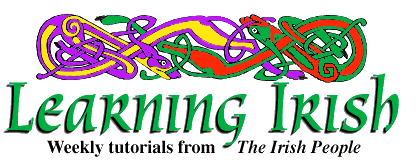
Irish Lesson 18
|
PRONUNCIATION In going from the broad vowel "á" in a word to a slender consonant, such as slender "d", "r", "s", or "t", the movement of the tongue to get into position for the slender consonant will result in an extra sound between vowel and consonant. The extra sound is called a "glide". It is usually shown in writing by the letter "i", and this indicates that the following consonant gets its slender sound. The overall effect can be somewhat like (oy) in English "boy", but you should not try to pronounce an (oy) for these cases. To see what this means, first review the pronunciation of slender and broad "t" in Lesson 2, and then slowly pronounce: át (aw*t), áit (AW*-it). Notice that in "áit" you make a slight (i) sound as your tongue tip goes to the hard ridge behind your upper teeth. In some parts of Ireland, the word "áit" may even sound like (oych). Here are some examples for practice. Review the pronunciation of slender and broad consonants if necessary, before starting: bád *baw*d); báid (BAW*-id) pád (paw*d); Páid (PAW*-id) lár (law*r); láir (LAW*-ir) pás (paw*s); páis (PAW*-ish); páista (PAW*-ish-te) trád (traw*d); tráid (TRAW*-id) srád (sraw*d); sráid (SRAW*-id) i lár na sráide (i LAW*R nuh SRAW*-id-e) It is a shortcoming of our simplified pronunciation guide that we can not show this transition or glide as well as it should be, so it will be your task to watch for it and make sure that your pronunciation includes it. We will usually show a word like 'báid" to be pronounced (baw*d), and you must note the "id" at the word end and give the "d" its slender sound, with the tongue tip against the hard ridge behind your upper front teeth. GRAMMAR "Ag" means "at", and it also serves to express "to have", as in "Tá cóta ag Seán" (taw* KOH-tuh eg shaw*n), John has a coat. You may think that use of "ag" for these two purposes would be confusing, but that is not so in the actual Irish language. You can tell from the nature of the sentence and the circumstances in which it is used whether "ag" is "at" or is part of the idea of "having". For example, Tá Seán ag an doras" must mean that John is at the door. Obviously the door does not "have" John. On the other hand, "Tá carr ag Seán" means that John has a car, rather than a car is "at John", or even at John's house. Irish has another expression for "at some one's house": "tigh Sheáin" (tee HYAW*-in). PROGRESSIVE DRILL Go through the following drill for expressing "to have" in Irish. Remember to recite aloud and form a mental picture for each sentence. An bhfuil nuachtán agam? (un vwil NOO-uhk*-taw*n uh-GUHM). Níl nuachtán agat (neel NOO-uhk*-taw*n uh GUHM) Tá nuachtán agat (uh-GUHT). An bhfuil nuachtán agat? Níl nuachtán agat. Tá nuachtán aige (eg-GE). An bhfuil nuachtán aige? And so on, until you return to "Tá nuachtán agam" as the last sentence. VOCABULARY Here are some phrases to help you learn how "ag an" (eg un), at the, causes eclipses. "Ag an" does not always cause eclipses, especially in the case of words starting with "d" or "t", but learn the eclipses for all cases initially.
bean, ag an mbean (ban, eg un man), woman, at the woman fear, ag an bhfear (far, eg un var), man, at the man doras, ag an ndoras (DUH-ruhs, eg un NUH-ruhs), door, at the door carr, ag an gcarr (kahr, eg un gahr), car, at the car páista, ag an bpáiste (PAW*SH-te, eg un BAW*SH-te), child, at the child geata, ag an ngeata (GAT-uh, eg ung AT-uh), gate, at the gate teach, ag an dteach (tahk*, eg un dyahk*), house, at the house CONVERSATION Pól: (pohl): Dia duit, a Róisín (DEE-uh git, uh roh-SHEEN). Hello, Rose. Róisín: Dia's Muire duit, a Phóil (DEE-uhs MWIR-uh git, uh FOH-il). Conas tá tú? (KUN-uhs taw* too) Hello, Paul. How are you? Pól: Tá mé go maith (taw* may* goh mah). Agus conas tá tú féin? I am well. And how are you? Róisín: Tá mé go maith leis (lesh). I am well, too. Pól: An bhfuil aon scéal nua agat? (un vwil ay*n shkay*l NOO-uh uh-GUHT) Have you any news? ("new story," literally). Róisín: Níl. Ach bhí mé ag léamh an nuachtáin aréir (uh LAY*-uhv un NOO-uhk-taw*-in uh-RAY*R). I don't. But I was reading the paper last night. Rud suimiúil a chonaic mé (rud sim-OO-il uh K*UHN-ik may*). An interesting thing I saw. Tá raidió agus teilifíseán ag beagnach gach duine sa tír seo (taw* RAH-dee-oh AH-guhs TEL-i-fee-shaw*n eg BYUHG-nahk* gahk* DIN-e suh teer shuh). Nearly everyone in this country has a radio and television set. Pól: Níl teilifíseán agamsa (uh-GUHM-suh). I don't have a television. An bhfuil teilifíseán agatsa? Have you one? Róisín: O, tá, agus tá ceann (kyoun) ag gach cara eile liom (KAH-ruh EL-e luhm). Oh, I do, and every other friend of mine has one. (c) 1997 The Irish People. May be reprinted with credit. |